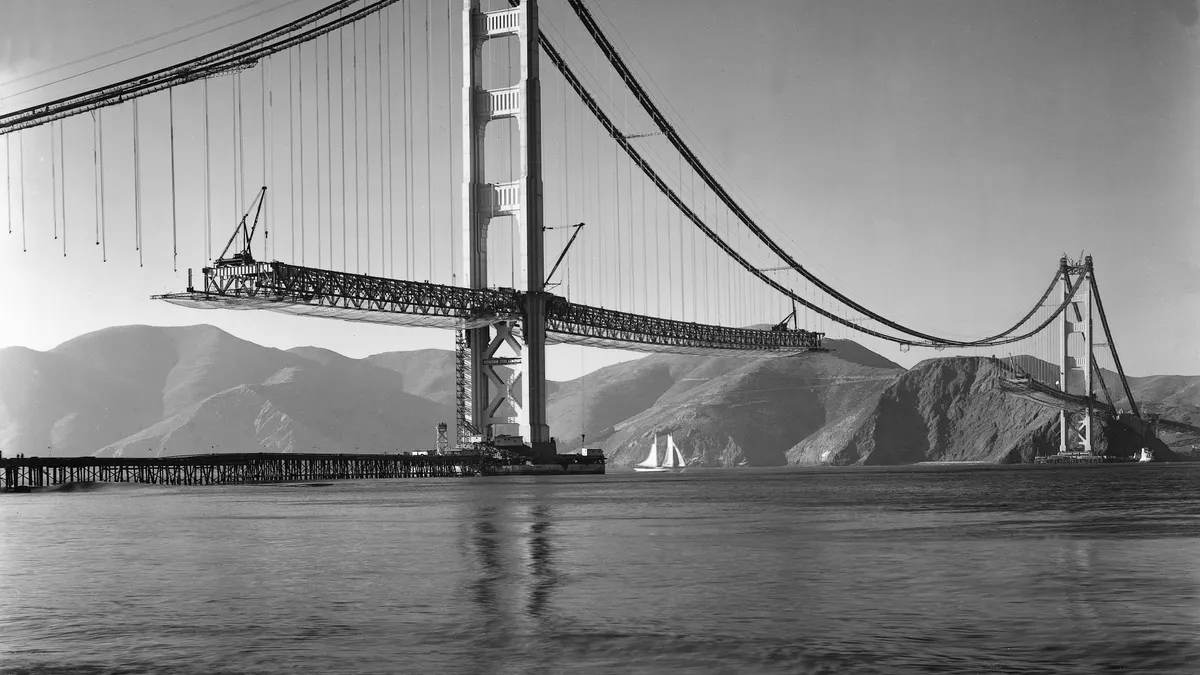When one thinks of San Francisco, it's likely that several images come to mind — foggy, hilly streets; Alcatraz Island; Chinatown and Fisherman's Wharf, just to name a few. However, there is perhaps no image more iconic that that of the Golden Gate Bridge.
Once the longest span in the world, the orange, 8,981-foot-long bridge first opened in May of 1937 after four years of construction worth $27 million, which would total significantly more than $1 billion if it had to be built today.
The bridge project was also a safe one, losing only one worker in 1936 until a scaffold collapse took the lives of 10 more a few months before the bridge was complete and open to the public. In fact, at a time when one death per $1 million of construction work was the accepted norm on a project of its size, the Golden Gate Bridge was a record-setter in the safety arena, largely due to a movable safety net installed under active work areas.
The so-called Halfway-to-Hell Club, or the group of construction workers saved by the net during the course of construction, numbered 19 by the project's end.
The net extended 10 feet out from both sides of the construction zone so that even those blown off the bridge by high winds could potentially be saved.
This and other safety features came at the insistence of chief bridge engineer Joseph Strauss, who also personally made sure that workers were tied to the bridge with safety lines at all times. Strauss reportedly did not hesitate to fire those who did not comply.
A first in "safety-first" In addition to safety lines and a safety net, Joseph Strauss, the Golden Gate Bridge's chief engineer, also insisted that workers wear one of the first construction hardhats at all times. Designed by Edward W. Bullard, the "Hard Boiled" hat was made of steamed canvas, glue.
Bullard also included the world's first piece of industrial head protection by installing a suspension system inside the hat. Inspired by the protective qualities of the hat, Strauss created the first-ever hardhat area at the Golden Gate bridge construction site.
Today, Golden Gate Bridge officials have decided to erect yet another net, this one with the potential to save the lives of those who try to commit suicide by jumping approximately 220 feet from the bridge into the Golden Gate Strait, the waters dividing the San Francisco Bay and the Pacific Ocean.
While the Golden Gate Bridge District does not keep an official count of those who have killed themselves at the bridge since it opened in the 1930s, according to CNN, the death toll now totals approximately 1,700. Only the Nanjing Yangtze River Bridge in China draws more individuals intent on harming themselves.
For years, mental health advocates like those at the Bridge Rail Foundation have pushed for construction of an anti-suicide feature on the bridge, as increased monitoring of pedestrians by authorities and strategically placed telephones offering help did not produce the desired results.
Interestingly, Strauss included a five-foot-plus fence in his original bridge design in order to prevent people from jumping off, but it was removed by the project architect. The first suicide at the bridge was a few months after it opened in 1937.
The idea of a modern physical barrier also met with resistance, this time from preservation groups that did not want bridge views negatively affected or historic features of the bridge damaged. After all, the bridge pulls in about 10 million tourists a year expecting to see the original Golden Gate in all its glory.
There was also a theory from those who opposed the barrier project that individuals set on killing themselves would find a way to do so. The thought was that if it weren't at the Golden Gate, it would be elsewhere. Pro-barrier advocates frequently cite a 1978 study that maintains that 90% of those who are stopped in their effort to commit suicide will not try again.
As for concerns about the aesthetic, the design is about as unobtrusive as such a project can be. Barrier components will be painted the same International Orange color as the Golden Gate, and the safety net's struts will mimic the 50-foot spacing of the bridge's suspender ropes.
The $211 million HNTB-designed Suicide Deterrent Barrier project, or safety net, will be positioned 20 feet — about two stories — underneath the bridge. It will also jut out 20 feet from either side, which means those who try to jump will land on the hard metal structure, likely sustaining significant injuries but able to survive the fall.
Poised to be the largest-scale use of a bridge suicide net in the U.S., the joint venture of Shimmick Construction (an AECOM company) and Danny's Construction will install the net along most of the length of the bridge using approximately 385,000 square feet of marine-grade stainless steel. The joint venture will also furnish and install 600 tons of steel supports for the net. Taking into account the entire scope of the barrier project, including the replacement and addition of bridge maintenance travelers and rail, Shimmick and Danny's will replace thousands of rivets with high-strength bolts.
Part of the contract also includes a wind retrofit to address concerns that a structure such as the suicide barrier could catch the wind and damage the Golden Gate. To solve this potential issue, the joint venture will install a 425-ton steel wind retrofit system along the main span on the west side of the bridge.
Portland, Oregon-based Vigor is manufacturing components for both the net's steel support system and the wind retrofit.
When the project is complete in 2021, the hope is that the Golden Gate Bridge will no longer be a magnet for those who wish to end their lives, but a symbol of San Francisco's commitment to safety. Strauss would no doubt approve.














